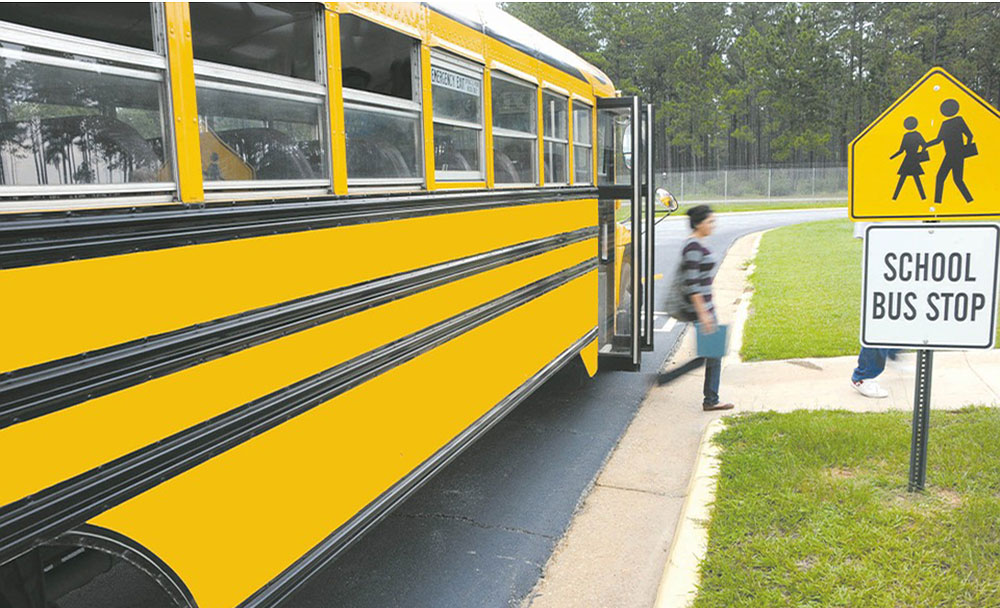Here’s 20 school bus safety tips every school district should consider.
1. Discourage, Deter Speeding
“No need to speed” is a message emphasized at Virginia Beach (Va.) City Public Schools.
“Our drivers are taught that safety trumps schedule at all times,” says David Pace, director of transportation services.
To make sure that policy is being heeded, the transportation department uses an unmarked radar car to perform random speed checks.
“We also have GPS on all our buses that allows us to monitor individual buses and their speeds,” Pace says.
2. Keep Back Bus Seats Empty
For Tom Young, transportation director at Central Springs High School in Manly, Iowa, taking extra precautions to keep students free of injury while they ride buses isn’t superfluous.
He has stressed to his drivers to leave the back two sets of seats empty whenever possible, a tip passed on to him by Max Christensen, executive officer of school transportation at the Iowa Department of Education.
“We try to do so as often as we can,” Young says. “It goes back to several bus crashes that I have seen online. Most bus crashes happen from the rear of the bus.”
3. Use the 3-Bus Rule
At Shenandoah County (Va.) Public Schools, buses are unloaded at the district’s largest campus three at a time to allow a minimum number of students on the ground with the maximum amount of adult supervision, Transportation Supervisor Martin Quigley says.
“We have more than 700 vehicles that come in and out of our largest campus in the morning, and this creates an environment where accidents can be severe if we do not follow our procedures and keep students’ safety in the forefront.”
At school bus stops, the counting procedure is vital. “Children are the most vulnerable when they are loading and unloading,” says Charlie Hood, Florida state pupil transportation director. “The bus operator must count and account for every child, every time, at every stop, until each student is safely out of harm’s way.”
4. Have Drivers Wear Proper Shoes
At Sweetwater County School District #2 in Green River, Wyo., Transportation Director Randall Jensen says he often has to tackle the problem of his drivers failing to wear proper footwear while operating their school buses, particularly during the summer months.
Under the policy he has given his drivers, all footwear must have a hard sole, have a covered toe area, and be tied or strapped on tight enough to withstand an impact.
“With all of the problems with pedal misapplication, I think it is very important to have proper footwear when you drive a bus,” Jensen says.
5. Drivers Should Signal Students When It’s OK to Cross
Many in the industry recommend the use of a signal procedure for safe street crossings and urge parents to educate their children about road safety.
“I think too many times, parents take for granted that a school bus is invincible and nothing bad will happen,” says Amy Noggle, transportation director for Wayne Trace Local Schools in Haviland, Ohio. “Make sure parents are educated in the dangers of [the road] and that they reinforce the safety rules when children are young.”
At Waupaca (Wis.) School District, “If children must cross the street, they are to do so only with the driver directing them,” Transportation Director Lee Nowicki says.
Chloe Williams, vice president at B.R. Williams Inc. in Woodstown, N.J., describes her company’s crossing procedure.
“The students look directly at the driver, the driver checks and double checks that all traffic is stopped and then gives the students a thumbs-up. At that point, the students move into and across the road to board the bus.”
Eric Fritz, energy services manager at Escambia County School District in Pensacola, Fla., says that “[the signal system] helps the driver reinforce positive behaviors, and the students learn to trust their bus drivers because they know they are there for the students’ safety.”
In New York, bus drivers use a two-part signal, Fairport Central School District Director of Transportation Peter Lawrence notes. First the thumbs-up signal indicates that the coast is clear, and then the index finger points in the direction to travel.
6. Emphasize Appropriate Turning Techniques
When making left turns, drivers should keep their front wheels pointing forward until it is clear to turn, “thus preventing being knocked into oncoming traffic if the bus is rearended,” says George Horne, president of Horne Enterprises in Metairie, La.
Drivers should also employ the “rock and roll” maneuver. “Move forward and back, side to side, to ensure you have actually checked all areas for pedestrians or other vehicles that may be hiding in your dead spots,” says Allan Jones, state pupil transportation director for Washington.
Continual, correct use of school bus mirror systems – and keeping mirrors adjusted correctly — are key in reducing accidents. “Having the awareness of your blind spots — behind the mirror itself, for instance – is critical,” Jones says.
7. Keep the Shop Clean
“A clean shop is a safe shop” is the motto of Brad Barker, shop manager at Park City (Utah) School Distict.
Floors should be kept as clean as possible to avoid slipping. Oil and grease should be wiped up when spills occur. Air hoses should be kept clean and leak-free; tools should be clean, orderly and in easy access for the job at hand. Additionally, the work area should be well lighted.
Barker also notes the importance of being careful when working under buses raised on hoists. “Before walking under the bus, look down to inspect for tripping hazards or open holes at the sliding hoist plates,” he says. “Look around for any other hazards, and look up for anything hanging low that you could bump your head on.”













